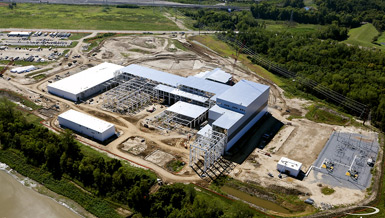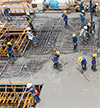Project definition helps the owner determine if the project is viable or not, aligns project expectations, and helps define a roadmap for the project delivery process. It results in early identification of possible problems and where they might occur, allowing for risk mitigation. The result is a reduction in the number of changes, unexpected costs, and variations of schedule during the execution of the project. The process also promotes alignment and efficiency among team members.
Corporations are managing smaller and less-forgiving capital budgets, so their capital appropriation processes are becoming more stringent. For many industrial owners, the traditional approach of a pure design study that includes a +/- 30 percent cost estimate is not sufficient. Industrial owners are requiring the services of integrated design and construction firms that have proven processes, systems, and technology to support the project development and delivery process. Increasingly, owners’ project managers do not have the latitude or time for design and cost development that the traditional design-bid-build process requires, so they look for a single source of accountability for project delivery.
Today owners have less project and construction support on their bench, and are increasingly relying on design and construction firms for that support.
This evolution has led to a more widespread adoption of engineering-led “engineer-procure-construct” (EPC) for industrial projects, where planning, design, procurement, and construction are integrated. The preconstruction process focuses on the development of realistic project definitions and “go to market”-based cost estimates. Establishing a project definition helps ensure that resources are used effectively, especially for projects that are not well defined, or for projects that have complex design and functionality.
What Is the New Normal?
Manufacturing experts are responding to this new set of needs by developing ways to capitalize upon the knowledge at their disposal, effectively capturing, organizing, communicating, and expanding upon it. They are bringing a high level of precision to project planning and scope definition.
Today owners have less project and construction support on their bench, and are increasingly relying on design and construction firms for that support. Details that need to be considered at the project outset include everything from historical costs and actual market costs to detailing the intricacies of scheduling. This process should address the facility, equipment, process utilities, and the site.
A qualified EPC can identify and quantify clients’ project needs quickly and accurately, and offer an array of formal procedures for walking their client through project definition. By the end of a successful project definition during the preconstruction phase, the entire team has a firm grasp on its cost, scope, and schedule.

Each industrial project is unique and has numerous variables that will impact it. Failure to invest in the project definition process can result in projects that have the wrong scope and inaccurate cost expectations. The preconstruction approach also evaluates the constructability of the project and identifies opportunities for value engineering. In addition, it provides the owner with a number of deliverables including an execution plan, risk analysis, and a procurement plan.
Common deliverables include:
- Site analysis
- Project feasibility
- Critical path schedule
- Evaluation of utilities
- Comparison of equipment selections
- Evaluation of soil conditions
- Identification of permitting requirements and potential issues
- Value engineering/cost-saving options
- Constructability reviews
Technology is increasingly becoming a critical part of this process. EPC firms are utilizing site and project assessment technology in conjunction with building information technology (BIM) to work in collaboration with owners to create a detailed 3D model that provides instant feedback on data such as cost, energy, lifecycle, cut and fill, and schedule. This approach enables a clearer way to review a proposed project and understand the assumptions and the cost-drivers. Owners can easily evaluate trade-offs across disciplines to find the best overall solution.
These technologies combine visual verification and data-capturing capabilities in a single model and therefore provide a major breakthrough in predictability. Formulas drive costs on each system based on the specific design, materials, site conditions, phasing, and other parameters, thereby producing extremely accurate information in a short time period. By combining this technology with a historical database, EPC firms can help owners make more informed decisions, target value design opportunities, and integrate lean methodology, while defining cost, scope, and schedule for capital projects.
Early project definition and a formal approach to capital appropriation highlight where there are specific risks to success, especially from a design and cost standpoint.
Characteristics of a Productive Project Definition and Capital Appropriation Process
Early project definition and a formal approach to capital appropriation highlight where there are specific risks to success, especially from a design and cost standpoint. These efforts also achieve efficiencies by helping EPC firms understand an owner’s approach, thought process, and critical items when executing capital projects.
Successful project definition should exhibit the following characteristics:
- Every potential project is viewed as an opportunity for savings.
- Capital is directed toward the areas that best benefit the organization’s overall goals.
- Stakeholders are included in the front-end loading process at the appropriate times.
- Each step in the capital process is connected to and builds on the previous step.
- Long-term requirements are considered at the front-end of a project.
- “Gates,” or review processes, ensure that projects meet owner-established criteria at the beginning of the project in order to move forward.
Case in point is a $230 million transformer manufacturing plant in the Southeast U.S. Early teamwork on the part of the owner and the EPC firm — and their focus on scope, cost, and schedule definition — resulted in a successful end product. The client was able to reap the benefits of having clear project definition, enabling them to negotiate and develop their project-funding model very early in the process; they were then able to meet their production and product delivery requirements.
The 350,000-square-foot, state-of-the-art integrated facility features a unique product testing and commissioning area, manufacturing, barge and rail access, and employee and customer amenities. The design incorporates sustainable design principles, including glass curtain walls to maximize natural light.
The facility is designed for the efficient and economical shipping of finished product with the option for rail, truck, and water/barge. The project includes a new rail spur and a new bridge to cross an easement. A new concrete dock supported with steel piles and a concrete sea wall includes a covered steel structure that houses cranes for loading finished product onto barges.
In this example, the client engaged the EPC firm during the site selection process to help define cost, scope, and schedule. A collaborative approach to project development resulted in a facility that met the corporate objectives of the manufacturer.
Encountering budget shortfalls or schedule overruns once a construction project is under way can set off a cascade of problems. Fortunately for industrial project owners, taking a proactive and collaborative approach and using proven tools and technology takes the guesswork out of predicting a project’s scope, cost, and schedule. Implementing these tools as part of a comprehensive preconstruction phase is the key to arriving at a project definition that will lead to successful project delivery.



